(完整word版)第二语言习得概论-考研复习
- 格式:doc
- 大小:64.01 KB
- 文档页数:7
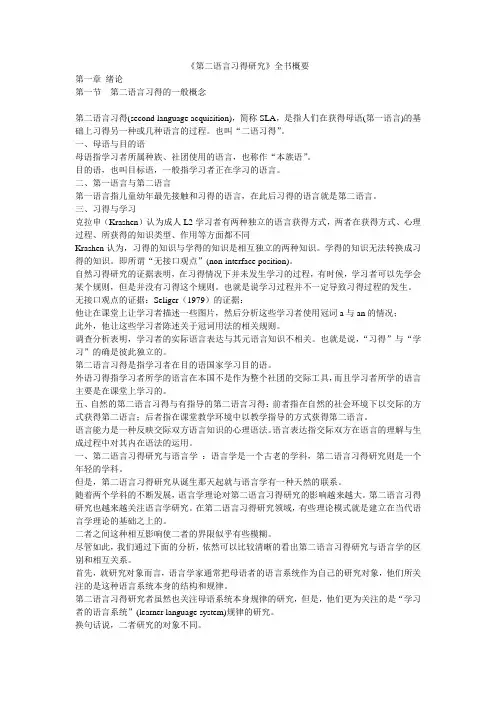
《第二语言习得研究》全书概要第一章绪论第一节第二语言习得的一般概念第二语言习得(second language acquisition),简称SLA,是指人们在获得母语(第一语言)的基础上习得另一种或几种语言的过程。
也叫“二语习得”。
一、母语与目的语母语指学习者所属种族、社团使用的语言,也称作“本族语”。
目的语,也叫目标语,一般指学习者正在学习的语言。
二、第一语言与第二语言第一语言指儿童幼年最先接触和习得的语言,在此后习得的语言就是第二语言。
三、习得与学习克拉申(Krashen)认为成人L2学习者有两种独立的语言获得方式,两者在获得方式、心理过程、所获得的知识类型、作用等方面都不同Krashen认为,习得的知识与学得的知识是相互独立的两种知识。
学得的知识无法转换成习得的知识。
即所谓“无接口观点”(non-interface position)。
自然习得研究的证据表明,在习得情况下并未发生学习的过程,有时候,学习者可以先学会某个规则,但是并没有习得这个规则。
也就是说学习过程并不一定导致习得过程的发生。
无接口观点的证据:Seliger(1979)的证据:他让在课堂上让学习者描述一些图片,然后分析这些学习者使用冠词a与an的情况;此外,他让这些学习者陈述关于冠词用法的相关规则。
调查分析表明,学习者的实际语言表达与其元语言知识不相关。
也就是说,“习得”与“学习”的确是彼此独立的。
第二语言习得是指学习者在目的语国家学习目的语。
外语习得指学习者所学的语言在本国不是作为整个社团的交际工具,而且学习者所学的语言主要是在课堂上学习的。
五、自然的第二语言习得与有指导的第二语言习得:前者指在自然的社会环境下以交际的方式获得第二语言;后者指在课堂教学环境中以教学指导的方式获得第二语言。
语言能力是一种反映交际双方语言知识的心理语法。
语言表达指交际双方在语言的理解与生成过程中对其内在语法的运用。
一、第二语言习得研究与语言学:语言学是一个古老的学科,第二语言习得研究则是一个年轻的学科。
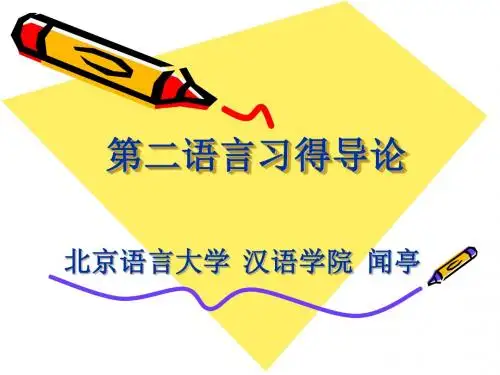
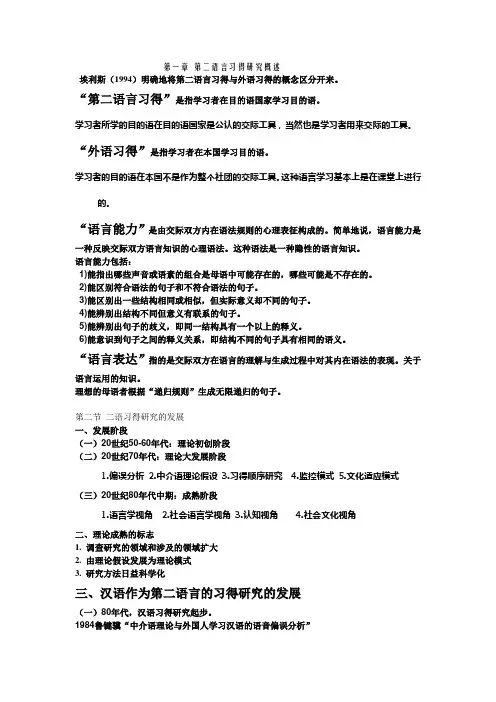
第一章第二语言习得研究概述埃利斯(1994)明确地将第二语言习得与外语习得的概念区分开来。
“第二语言习得”是指学习者在目的语国家学习目的语。
学习者所学的目的语在目的语国家是公认的交际工具,当然也是学习者用来交际的工具。
“外语习得”是指学习者在本国学习目的语。
学习者的目的语在本国不是作为整个社团的交际工具。
这种语言学习基本上是在课堂上进行的。
“语言能力”是由交际双方内在语法规则的心理表征构成的。
简单地说,语言能力是一种反映交际双方语言知识的心理语法。
这种语法是一种隐性的语言知识。
语言能力包括:1)能指出哪些声音或语素的组合是母语中可能存在的,哪些可能是不存在的。
2)能区别符合语法的句子和不符合语法的句子。
3)能区别出一些结构相同或相似,但实际意义却不同的句子。
4)能辨别出结构不同但意义有联系的句子。
5)能辨别出句子的歧义,即同一结构具有一个以上的释义。
6)能意识到句子之间的释义关系,即结构不同的句子具有相同的语义。
“语言表达”指的是交际双方在语言的理解与生成过程中对其内在语法的表现。
关于语言运用的知识。
理想的母语者根据“递归规则”生成无限递归的句子。
第二节二语习得研究的发展一、发展阶段(一)20世纪50-60年代:理论初创阶段(二)20世纪70年代:理论大发展阶段1.偏误分析2.中介语理论假设3.习得顺序研究4.监控模式5.文化适应模式(三)20世纪80年代中期:成熟阶段1.语言学视角2.社会语言学视角3.认知视角4.社会文化视角二、理论成熟的标志1. 调查研究的领域和涉及的领域扩大2. 由理论假设发展为理论模式3. 研究方法日益科学化三、汉语作为第二语言的习得研究的发展(一)80年代,汉语习得研究起步。
1984鲁键骥“中介语理论与外国人学习汉语的语音偏误分析”1985年,第一界国际汉语教学讨论会1987年,吕必松“加强对外汉语教学的理论研究”评价:取得了一定成果,但缺乏系统研究、分析方法不够严谨、疏于解释和评价。

题目:第二语言习得文献综述学号: 20130291001 学生姓名:赵亚雯院部:研究生院专业:汉语国际教育内容摘要本篇文献综述将所阅读的60篇文章分为六个部分:中介语与第二语言习得、“关键期假说”、“输入与输出假说”、“普遍语法”与二语习得、影响二语习得的诸因素等,每个部分选取了几篇具有代表性的文章进行综合阐述,通过对每篇文章内容的归纳与总结,得出了一些与二语习得相关的理论,同时选取部分学者有研究、借鉴价值的文章进行简单的评述。
例如,语际语及其在第二语言习得中的地位、关键期假说理论与第二语言习得、第二语言习得中的语言输入与语言输出、第二语言习得过程中语言迁移现象的研究等等,并在此基础上提出了自己对部分文献的看法以及对对外汉语教学产生的启示和值得借鉴的地方。
关键词:第二语言习得中介语关键期输入输出普遍语法影响因素目录一、中介语与第二语言习得 (1)二、“关键期假说”与第二语言习得 (3)三、“输入假说”与“输出假说” (6)四、“普遍语法”与二语习得 (10)五、影响二语习得的因素 (13)六、其他 (18)一、中介语与第二语言习得代表文章:《语际语及其在第二语言习得中的地位》宋德生《汉语环境与中介语僵化现象起因探讨》黄冬梅《二语习得中介语以及对外语教学的启示》张磊《过渡语及其典型特征分析》赵晨中介语又叫“语际语”、“过渡语”和“学习者的语言”,1972年由Selinker首先使用。
中介语是第二语言学习者在第二语言学习中形成的一种特定语言系统,这种语言系统在语音、词汇、语法、语用等方面,既不同于学习者的第一语言,也不同于所学习的目的语,而是一种随着学习的发展向目的语的正确形式逐渐靠拢的一种动态的语言系统。
它是一种介于第一语言和目的语之间的一种过渡的语言系统,因此也被称为“中间语”。
不同学者对中介语的性质和解释有所不同,但综合Adjemian(1976)、Corder(1987)、Ellis(1994)、Selinker和Lashmanan(1992)等学者的观点,中介语有如下一些特点:1.系统性,中介语的规则是系统变化的。
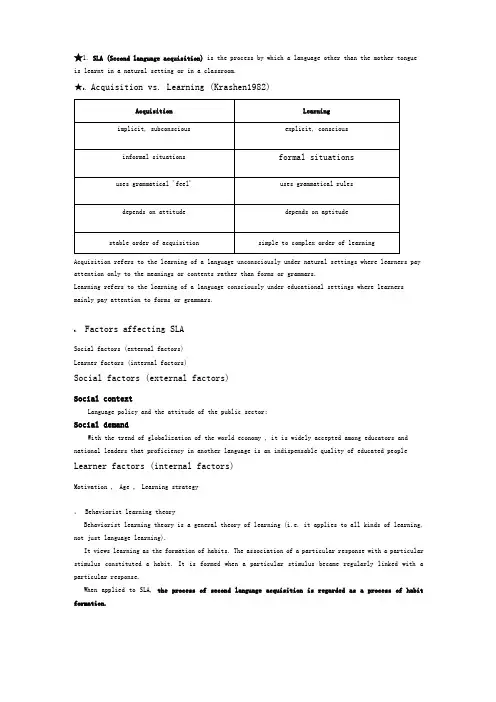
★1. SLA (Second language acquisition) is the process by which a language other than the mother tongue is learnt in a natural setting or in a classroom.★2. Acquisition vs. Learning (Krashen1982)Acquisition refers to the learning of a language unconsciously under natural settings where learners pay attention only to the meanings or contents rather than forms or grammars.Learning refers to the learning of a language consciously under educational settings where learners mainly pay attention to forms or grammars.3.Factors affecting SLASocial factors (external factors)Learner factors (internal factors)Social factors (external factors)Social contextLanguage policy and the attitude of the public sector;Social demandWith the trend of globalization of the world economy , it is widely accepted among educators and national leaders that proficiency in another language is an indispensable quality of educated people Learner factors (internal factors)Motivation , Age , Learning strategyBehaviorist learning theory4.Behaviorist learning theory is a general theory of learning (i.e. it applies to all kinds of learning, not just language learning).It views learning as the formation of habits. The association of a particular response with a particular stimulus constituted a habit. It is formed when a particular stimulus became regularly linked with a particular response.When applied to SLA, the process of second language acquisition is regarded as a process of habit formation.5.The causes of errors according to behaviorismDifferences between the first and second language create learning difficulty which results in errors. Behaviorist learning theory predicts that transfer will take place from the first to the second language. Transfer will be negative when there is proactive inhibition. In this case errors will result. Errors, according to behaviorist theory, were the result of non-learning, rather than wrong learning. The means used to predict potential errors by behaviorists is Contrastive Analysis.Structuralism6.Language was viewed as a coded system consisting of structurally related elements (phonemes, morphemes, words, structures and sentence patterns)7.What is contrastive analysis (CA)?Contrastive analysis is an inductive investigative approach based on the distinctive elements in a language. It involves the comparison of two or more languages or subsystems of languages in order to determine both the differences and similarities between them. It could also be done within one language. Contrastive analysis can be both theoretical and applied according to varied purposes.8.Contrastive Analysis Hypothesis (CAH)Contrastive analysis is a way of comparing languages in order to determine potential errors for the ultimate purpose of isolating what needs to be learned and what does not need to be learned in an L2 situation.According to CAH, L2 errors are result of differences between the learner ’s first language andthe target language. The strong form of the hypothesis claims that these differences can be used to predict all errors that will occur. The weak form of the hypothesis claims that these differences can be used to identify some out of the total errors that actually arise.difference vs difficulty9.“Difference” is a linguistic concept, whereas “difficulty” is a psychological concept. Therefore, the level of learning difficulty cannot be inferred directly from the degree of difference between two language systems.10.Definition of Error analysis (EA)the study and analysis of the errors made by second and foreign language learners (Longman Dictionary of Applied Linguistics, p.96).It involves collecting samples of learner language, identifying the errors in these samples, describing these errors, classifying them according to their hypothesized causes, and evaluating theirs seriousness.Interlingual error: deviated forms resulting from the interference of one,s L1, or the negative11.transfer of one,s mother tongue.Intralingual error:①deviated forms in learner language that reflect learners, transitional competence and which are the results of such learning process as overgeneralization.② confusion of L2 rules12.Factors causing errorsnguage transfer2.Overgeneralization3.Learner differences4.Strategies in L2 learning5. Strategies of L2 communicatione.g. The two students changed eyes and eyebrows in class.13.Types of learner strategyLearning strategy, Production strategy 表达策略Communication strategy:Communication strategies are employed when learners are faced with the task of communicating meanings for which they lack the requisite linguistic knowledge. Typical communication strategies are paraphrase and mime.14.Classifications of learning strategy(Cohen 2006)(2)By function: Metacognitive; Cognitive; Socio-affective(3)By skill: listening, speaking, reading, writing, vocabulary, or translation strategies.15.Meta-cognitive strategiesMeta-cognitive strategy is the planning for learning, thinking about the learning process, monitoring of one,s production or comprehension, and evaluating learning after an activity is completed.16.Cognitive strategiesCognitive strategies refer to the steps or operations used in learning or problem-solving that require direct analysis, transformation, or synthesis of learning material.Repetition, Resourcing, Directed physical response, Translation, Grouping, Note-taking , Deduction Recombination, Imagery, Auditory representation, Key word, Contextualization, Elaboration, Transfer, Inferencing17.Individual learner variablesPersonal factors:group dynamics; attitudes to the teacher and course materials; learning techniques General factors: age; aptitude; cognitive style; motivation; personality18.MotivationIntegrative motivation 融合型动机is present in learners who identify with the target culture, would like to resemble members of the target culture and who would like to participate in the target culture. It is assumed to be based in the personality of the learner.Instrumental orientation 工具型动机refers to those cases where the learners are interested in learning the language for the possible benefits, that is, the learner5 s goal is functional. Resultative motivation:因果性动机Learners’ motivation is strongly affected by their achievement. Intrinsic motivation:内在兴趣动机Motivation as intrinsic interest.Motivation as a multi-componential construct:Motivation = effort + desire to achieve goal + attitudesTask motivation: the interest felt by the learner in performing different learning tasks.★ 19Definition -interlanguageInterlanguage is the approximate language system that the learner constructs for use in communicationthrough the target language. (Larry Selinker)It is independent of both the learner’s first language and the target language.It suggests that learners, language is between L1 AND L2 and that it is a continuum along which all learners traverse.★20.Definition of fossilizationFossilization refers to the state in which the second language learners stop to learning when their internalized rule system contains rules different from the target language. That is to say, the interlanguage stops evolving towards the TL.21.Classification of fossilizationTemporary fossilization: the phenomenon is alterable under certain conditions.Permanent fossilizationThis means the learner,s language stops evolving forever. Because stable stage is not real fossilization, so there is no real permanent fossilization.22.Causes of fossilizationInternal: Motivation; Communicative needs; Acquisition device External: Communicative pressure Lack of learning opportunities Feedback:positive cognitive feedbacks cause fossilization ; (e.g, “Oh,I see”)negative feedbacks help to prevent fossilization. (e.g. “I don’t understand you” )★23Definition of UGCook(1985) summarizing the Chomskyan position, defines ‘universal grammar, as ‘the properties inherent in the human mind,. Universal grammar consists of a set of general principles that apply to all language rather than a set of particular rules.. Markedness24Markedness refers to the idea that some linguistic structures are ‘special, or ‘less natural, or ‘less basic, than others.Linguists working in the Chomskyan school suggest that linguistic rules can either be part of the core grammar (i.e. the universal rules) or be part of the periphery.Core rules are considered to be unmarked and therefore easily acquired.Periphery roles are considered to be and therefore different to learn.25Krashen's Monitor ModelKrashen's monitor model mainly consists of the following five hypothses:(1)Acquisition-Learning Hypothesis:there are two kinds of ways of learning a second language ,i.e., acquisition and learning.(2)Natural Order Hypothesis:SLA follows a universal route that is not influenced by factors such as the learners7 first language, age, and the context (classroom or natural setting).Implications:Errors are developmental and are a natural byproduct of learning - tolerate them.Allow learners to make errors and do not correct them(3)The Input Hypothesis cIt laims a move along the developmental continuum by receiving comprehensible input.We acquire, only when we understand the structure that is “a little beyc where we are now Comprehensible input is defined as L2 input just beyond the Learner,s current L2 competence, in terms of its syntactic complexity. If a learner,s current competence is i then comprehensible input is i+1. Input which is either too simple (i) or too complex (i+2/3/4…)will not be useful for acquisition.(4)The affective filter hypothesisSLA is affected by factors like Motivation, Self-confidence, Anxiety and so on.Learners who suffer from anxiety or lack of motivation or negative attitude somehow switch off their comprehension mechanisms and so even if they are provided comprehensible input, they will not be able to process the input. Therefore a low affective filter is important.(5)Monitor hypothesisBoth language learners and native speakers typically try to correct any errors in what they have just said. This is referred to as monitoring.Krashen uses the term Monitoring (with a big M) to refer to the way the learner used learnt knowledge to improve utterances produced by means of acquired knowledge.nguage transferLanguage transfer is the influence resulting from the similarities and differences between the target language and any other language that has been previously( and perhaps imperfectly ) acquired.★27. LAD (language acquisition device)The LAD is a system of principles that children are born with that helps them learn language, and accounts for the order in which children learn structures, and the mistakes they make as they learn.★28. critical age period hypothesisIt claims that there a period when language acquisition can take place naturally and effortlessly, but after a certain age the brain is no longer able to process language input in this. Researchers differ over when the critical period comes to an end.★29. field independent vs. field independentLearners are different in the ways of receiving, conceptualizing, organizing, and recalling information. Field dependents operate holistically (i.e. they see the field as a whole),Whereas field independents operate analytically (i.e. they see the field in terms of its component parts).★30. input vs. intakeInput refers to the language learners are exposed to.It serves as the data which learners must useto determine the rules of the target language.However, not all available input is processed by the learner, either because some of it is not understood or because some of it is not attended to.That part of input that is processed, assimilated and fed into the interlanguage system is referred to as intake.★31.attitudes vs. aptitude vs. intelligenceAttitudes refer to the learner’s beliefs about factors such as the target language culture, their own culture, their teacher and the learning tasks they are given.Aptitude refers to the specific ability a learner has for learning a second language.Intelligence refers to the general ability to master academic skills.petence vs. performanceWhen learners acquire a L2, they internalize rules which are then organized into a system. This constitutes their competence.The actual use of this system to comprehend and produce utterances is referred to as performance.33.OvergeneralizationIt refers to the extension of some general rule to items not covered by this rule in the target language.34.foreigner talk vs. teacher talkWhen native speakers address learners, they make adjustments in both language form and language function to facilitate understanding. These adjustments are referred to as foreigner talk.When teachers address learners, they make adjustments in both language form and language function to facilitate understanding. These adjustments are referred to as foreigner talk.35.formulaic speech vs. patternsFormulaic speech consists of expressions which are learned as unanalysable wholes and employed in particular occasions.Patterns are one type of formulaic speech. They are unanalysable units which have one or more open slots, e.g. ‘Can I have a —’。
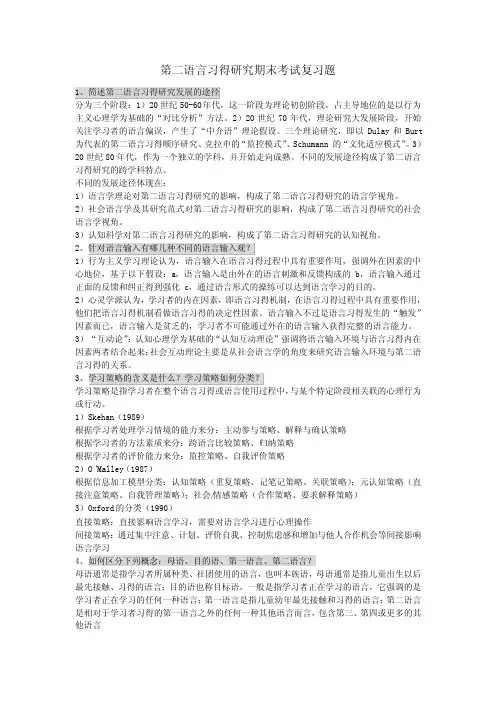
第二语言习得研究期末考试复习题1、简述第二语言习得研究发展的途径分为三个阶段:1)20世纪50-60年代,这一阶段为理论初创阶段,占主导地位的是以行为主义心理学为基础的“对比分析”方法。
2)20世纪70年代,理论研究大发展阶段,开始关注学习者的语言偏误,产生了“中介语”理论假设。
三个理论研究,即以Dulay和Burt 为代表的第二语言习得顺序研究、克拉申的“监控模式”、Schumann的“文化适应模式”。
3)20世纪80年代,作为一个独立的学科,并开始走向成熟。
不同的发展途径构成了第二语言习得研究的跨学科特点。
不同的发展途径体现在:1)语言学理论对第二语言习得研究的影响,构成了第二语言习得研究的语言学视角。
2)社会语言学及其研究范式对第二语言习得研究的影响,构成了第二语言习得研究的社会语言学视角。
3)认知科学对第二语言习得研究的影响,构成了第二语言习得研究的认知视角。
2、针对语言输入有哪几种不同的语言输入观?1)行为主义学习理论认为,语言输入在语言习得过程中具有重要作用,强调外在因素的中心地位,基于以下假设:a,语言输入是由外在的语言刺激和反馈构成的 b,语言输入通过正面的反馈和纠正得到强化 c,通过语言形式的操练可以达到语言学习的目的。
2)心灵学派认为,学习者的内在因素,即语言习得机制,在语言习得过程中具有重要作用,他们把语言习得机制看做语言习得的决定性因素。
语言输入不过是语言习得发生的“触发”因素而已,语言输入是贫乏的,学习者不可能通过外在的语言输入获得完整的语言能力。
3)“互动论”:认知心理学为基础的“认知互动理论”强调将语言输入环境与语言习得内在因素两者结合起来;社会互动理论主要是从社会语言学的角度来研究语言输入环境与第二语言习得的关系。
3、学习策略的含义是什么?学习策略如何分类?学习策略是指学习者在整个语言习得或语言使用过程中,与某个特定阶段相关联的心理行为或行动。
1)Skehan(1989)根据学习者处理学习情境的能力来分:主动参与策略、解释与确认策略根据学习者的方法素质来分:跨语言比较策略、归纳策略根据学习者的评价能力来分:监控策略、自我评价策略2)O’Malley(1987)根据信息加工模型分类:认知策略(重复策略、记笔记策略、关联策略);元认知策略(直接注意策略、自我管理策略);社会/情感策略(合作策略、要求解释策略)3)Oxford的分类(1990)直接策略:直接影响语言学习,需要对语言学习进行心理操作间接策略:通过集中注意、计划、评价自我、控制焦虑感和增加与他人合作机会等间接影响语言学习4、如何区分下列概念:母语、目的语、第一语言、第二语言?母语通常是指学习者所属种类、社团使用的语言,也叫本族语,母语通常是指儿童出生以后最先接触、习得的语言;目的语也称目标语,一般是指学习者正在学习的语言,它强调的是学习者正在学习的任何一种语言;第一语言是指儿童幼年最先接触和习得的语言;第二语言是相对于学习者习得的第一语言之外的任何一种其他语言而言,包含第三、第四或更多的其他语言5、简述社会文化理论的主要内容及意义主要内容:调节论:主要用于解释儿童的认知发展,在语言的调节下,儿童的认知从“客体调控”阶段发展到“他人调控”阶段,最后到“自我调控”阶段。
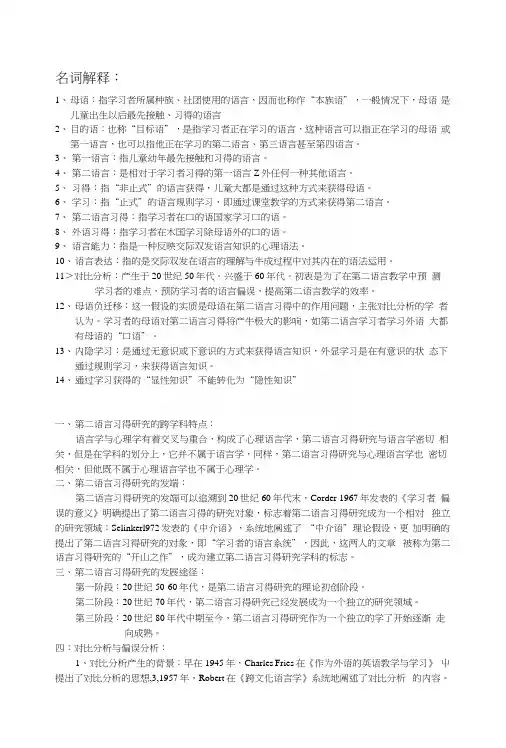
名词解释:1、母语:指学习者所属种族、社团使用的语言,因而也称作“本族语”,一般情况下,母语是儿童出生以后最先接触、习得的语言2、目的语:也称“目标语”,是指学习者正在学习的语言,这种语言可以指正在学习的母语或第一语言,也可以指他正在学习的第二语言、第三语言甚至第四语言。
3、第一语言:指儿童幼年最先接触和习得的语言。
4、第二语言:是相对于学习者习得的第一语言Z外任何一种其他语言。
5、习得:指“非止式”的语言获得,儿童大都是通过这种方式来获得母语。
6、学习:指“止式”的语言规则学习,即通过课堂教学的方式来获得第二语言。
7、第二语言习得:指学习者在口的语国家学习口的语。
8、外语习得:指学习者在木国学习除母语外的口的语。
9、语言能力:指是一种反映交际双发语言知识的心理语法。
10、语言表达:指的是交际双发在语言的理解与牛成过程中对其内在的语法运用。
11>对比分析:产生于20世纪50年代。
兴盛于60年代。
初衷是为了在第二语言教学中预测学习者的难点,预防学习者的语言偏误,提高第二语言教学的效率。
12、母语负迁移:这一假设的实质是母语在第二语言习得中的作用问题,主张对比分析的学者认为。
学习者的母语对第二语言习得将产牛极大的影响,如第二语言学习者学习外语大都有母语的“口语”。
13、内隐学习:是通过无意识或下意识的方式来获得语言知识,外显学习是在有意识的状态下通过规则学习,来获得语言知识。
14、通过学习获得的“显性知识”不能转化为“隐性知识”一、第二语言习得研究的跨学科特点:语言学与心理学有着交叉与重合,构成了心理语言学,第二语言习得研究与语言学密切相关,但是在学科的划分上,它并不属于语言学,同样,第二语言习得研究与心理语言学也密切相关,但他既不属于心理语言学也不属于心理学。
二、第二语言习得研究的发端:第二语言习得研究的发端可以追溯到20世纪60年代末,Corder 1967年发表的《学习者偏误的意义》明确提出了第二语言习得的研究对象,标志着第二语言习得研究成为一个相对独立的研究领域;Selinkerl972发表的《中介语》,系统地阐述了“中介语”理论假设,更加明确的提出了第二语言习得研究的对彖,即“学习者的语言系统”,因此,这两人的文章被称为第二语言习得研究的“开山之作”,成为建立第二语言习得研究学科的标志。
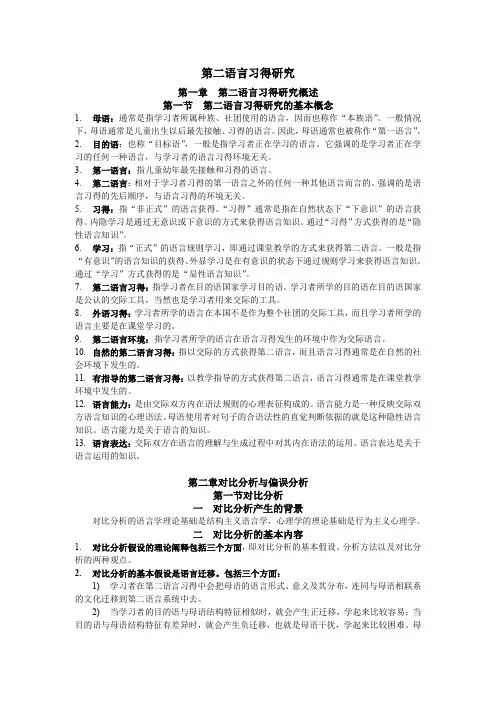
第二语言习得研究第一章第二语言习得研究概述第一节第二语言习得研究的基本概念1.母语:通常是指学习者所属种族、社团使用的语言,因而也称作“本族语”。
一般情况下,母语通常是儿童出生以后最先接触、习得的语言。
因此,母语通常也被称作“第一语言”。
2.目的语:也称“目标语”,一般是指学习者正在学习的语言。
它强调的是学习者正在学习的任何一种语言,与学习者的语言习得环境无关。
3.第一语言:指儿童幼年最先接触和习得的语言。
4.第二语言:相对于学习者习得的第一语言之外的任何一种其他语言而言的。
强调的是语言习得的先后顺序,与语言习得的环境无关。
5.习得:指“非正式”的语言获得。
“习得”通常是指在自然状态下“下意识”的语言获得。
内隐学习是通过无意识或下意识的方式来获得语言知识。
通过“习得”方式获得的是“隐性语言知识”。
6.学习:指“正式”的语言规则学习,即通过课堂教学的方式来获得第二语言。
一般是指“有意识”的语言知识的获得。
外显学习是在有意识的状态下通过规则学习来获得语言知识。
通过“学习”方式获得的是“显性语言知识”。
7.第二语言习得:指学习者在目的语国家学习目的语。
学习者所学的目的语在目的语国家是公认的交际工具,当然也是学习者用来交际的工具。
8.外语习得:学习者所学的语言在本国不是作为整个社团的交际工具,而且学习者所学的语言主要是在课堂学习的。
9.第二语言环境:指学习者所学的语言在语言习得发生的环境中作为交际语言。
10.自然的第二语言习得:指以交际的方式获得第二语言,而且语言习得通常是在自然的社会环境下发生的。
11.有指导的第二语言习得:以教学指导的方式获得第二语言,语言习得通常是在课堂教学环境中发生的。
12.语言能力:是由交际双方内在语法规则的心理表征构成的。
语言能力是一种反映交际双方语言知识的心理语法。
母语使用者对句子的合语法性的直觉判断依据的就是这种隐性语言知识。
语言能力是关于语言的知识。
13.语言表达:交际双方在语言的理解与生成过程中对其内在语法的运用。
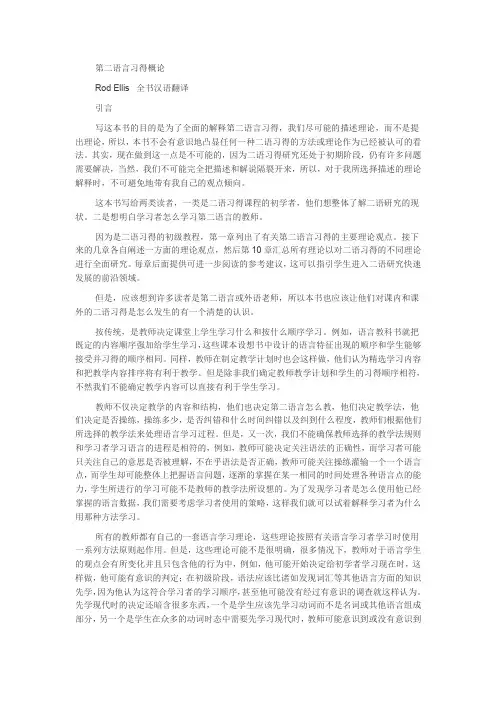
第二语言习得概论Rod Ellis 全书汉语翻译引言写这本书的目的是为了全面的解释第二语言习得,我们尽可能的描述理论,而不是提出理论,所以,本书不会有意识地凸显任何一种二语习得的方法或理论作为已经被认可的看法。
其实,现在做到这一点是不可能的,因为二语习得研究还处于初期阶段,仍有许多问题需要解决,当然,我们不可能完全把描述和解说隔裂开来,所以,对于我所选择描述的理论解释时,不可避免地带有我自己的观点倾向。
这本书写给两类读者,一类是二语习得课程的初学者,他们想整体了解二语研究的现状。
二是想明白学习者怎么学习第二语言的教师。
因为是二语习得的初级教程,第一章列出了有关第二语言习得的主要理论观点。
接下来的几章各自阐述一方面的理论观点,然后第10章汇总所有理论以对二语习得的不同理论进行全面研究。
每章后面提供可进一步阅读的参考建议,这可以指引学生进入二语研究快速发展的前沿领域。
但是,应该想到许多读者是第二语言或外语老师,所以本书也应该让他们对课内和课外的二语习得是怎么发生的有一个清楚的认识。
按传统,是教师决定课堂上学生学习什么和按什么顺序学习。
例如,语言教科书就把既定的内容顺序强加给学生学习,这些课本设想书中设计的语言特征出现的顺序和学生能够接受并习得的顺序相同。
同样,教师在制定教学计划时也会这样做,他们认为精选学习内容和把教学内容排序将有利于教学。
但是除非我们确定教师教学计划和学生的习得顺序相符,不然我们不能确定教学内容可以直接有利于学生学习。
教师不仅决定教学的内容和结构,他们也决定第二语言怎么教,他们决定教学法,他们决定是否操练,操练多少,是否纠错和什么时间纠错以及纠到什么程度,教师们根据他们所选择的教学法来处理语言学习过程。
但是,又一次,我们不能确保教师选择的教学法规则和学习者学习语言的进程是相符的,例如,教师可能决定关注语法的正确性,而学习者可能只关注自己的意思是否被理解,不在乎语法是否正确,教师可能关注操练灌输一个一个语言点,而学生却可能整体上把握语言问题,逐渐的掌握在某一相同的时间处理各种语言点的能力,学生所进行的学习可能不是教师的教学法所设想的。

第二语言习得概论考研复习精编W O R D版 IBM system office room 【A0816H-A0912AAAHH-GX8Q8-GNTHHJ8】★1. SLA (Second language acquisition) is the process by which a language other than the mother tongue is learnt in a natural setting or in a classroom.★2. Acquisition vs. Learning (Krashen1982)Acquisition refers to the learning of a language unconsciously under natural settings where learners pay attention only to the meanings or contents rather than forms or grammars.Learning refers to the learning of a language consciously under educational settings where learners mainly pay attention to forms or grammars.3. Factors affecting SLASocial factors (external factors)Learner factors (internal factors)Social factors (external factors)Social contextLanguage policy and the attitude of the public sector;Social demandWith the trend of globalization of the world economy , it is widely accepted among educators and national leaders that proficiency in another language is an indispensable quality of educated peopleLearner factors (internal factors)Motivation ,Age ,Learning strategy4. Behaviorist learning theoryBehaviorist learning theory is a general theory of learning (i.e. it applies to all kinds of learning, not just language learning).It views learning as the formation of habits. The association of aparticular response with a particular stimulus constituted a habit. It is formed when a particular stimulus became regularly linked with a particular response.When applied to SLA, the process of second language acquisition is regarded as a process of habit formation.5. The causes of errors according to behaviorismDifferences between the first and second language create learning difficulty which results in errors.Behaviorist learning theory predicts that transfer will take place from the first to the second language. Transfer will be negative when there is proactive inhibition. In this case errors will result.Errors, according to behaviorist theory, were the result of non-learning, rather than wrong learning.The means used to predict potential errors by behaviorists is Contrastive Analysis.6. StructuralismLanguage was viewed as a coded system consisting of structurally related elements (phonemes, morphemes, words, structures and sentence patterns)7. What is contrastive analysis (CA)Contrastive analysis is an inductive investigative approach based on the distinctive elements in a language. It involves the comparison of two or more languages or subsystems of languages in order to determine both the differences and similarities between them. It could also be done within one language. Contrastive analysis can be both theoretical and applied according to varied purposes.8. Contrastive Analysis Hypothesis (CAH)Contrastive analysis is a way of comparing languages in order to determine potential errors for the ultimate purpose of isolating what needs to be learned and what does not need to be learned in an L2 situation.According to CAH, L2 errors are result of differences between the learner’s first language and the target language. The strong form of the hypothesis claims that these differences can be used to predict all errorsthat will occur. The weak form of the hypothesis claims that these differences can be used to identify some out of the total errors that actually arise.9.difference vs difficulty“Difference” is a linguistic concept, whereas “difficulty” is a psychological concept. Therefore, the level of learning difficulty cannot be inferred directly from the degree of difference between two language systems. 10. Definition of Error analysis (EA)the study and analysis of the errors made by second and foreign language learners (Longman Dictionary of Applied Linguistics, p.96).It involves collecting samples of learner language, identifying the errors in these samples, describing these errors, classifying them according to their hypothesized causes, and evaluating theirs seriousness.11. Interlingual error: deviated forms resulting from the interference of one’s L1, or the negative transfer of one’s mother tongue.Intralingual error: ①deviated forms in learner language that reflect learners’ transitional competence and which are the results of such learning process as overgeneralization.②confusion of L2 rules12. Factors causing errors1. Language transfer2. Overgeneralization3. Learner differences3. Strategies in L2 learning5. Strategies of L2 communicatione.g. The two students changed eyes and eyebrows in class.13. Types of learner strategyLearning strategy, Production strategy 表达策略Communication strategy: Communication strategies are employed when learners are faced with the task of communicating meanings for which they lack the requisite linguistic knowledge. Typical communication strategies are paraphrase and mime.14. Classifications of learning strategy(Cohen 2006)(2) By function: Metacognitive; Cognitive; Socio-affective(3) By skill: listening, speaking, reading, writing, vocabulary, or translation strategies.15. Meta-cognitive strategiesMeta-cognitive strategy is the planning for learning, thinking about the learning process, monitoring of one’s production or comprehension, and evaluating learning after an activity is completed.16. Cognitive strategiesCognitive strategies refer to the steps or operations used in learning or problem-solving that require direct analysis, transformation, or synthesis of learning material.Repetition, Resourcing, Directed physical response, Translation, Grouping, Note-taking , Deduction Recombination, Imagery, Auditory representation, Key word, Contextualization, Elaboration, Transfer, Inferencing17. Individual learner variablesPersonal factors:group dynamics; attitudes to the teacher and course materials; learning techniquesGeneral factors:age; aptitude; cognitive style; motivation; personality18. MotivationIntegrative motivation 融合型动机is present in learners who identify with the target culture, would like to resemble members of the target culture and who would like to participate in the target culture. It is assumed to be based in the personality of the learner.Instrumental orientation工具型动机refers to those cases where the learners are interested in learning the language for the possible benefits, that is, the learner’s goal is functional.Resultative motivation:因果性动机 Learners’ motivation is strongly affected by their achievement.Intrinsic motivation:内在兴趣动机Motivation as intrinsic interest.Motivation as a multi-componential construct:Motivation = effort + desire to achieve goal + attitudesTask motivation: the interest felt by the learner in performing different learning tasks.★ 19. Definition –interlanguageInterlanguage is the approximate language system that the learner constructs for use in communication through the target language. (Larry Selinker)It is independent of both the learner’s first language and the target language.It suggests that learners’ language is between L1 AND L2 and that it is a continuum along which all learners traverse.★20.Definition of fossilizationFossilization refers to the state in which the second language learners stopto learning when their internalized rule system contains rules different from the target language. That is to say, the interlanguage stops evolving towards the TL.21. Classification of fossilizationTemporary fossilization: the phenomenon is alterable under certain conditions. Permanent fossilizationThis means the learne r’s language stops evolving for ever. Because stable stage is not real fossilization, so there is no real permanent fossilization. 22. Causes of fossilizationInternal: Motivation; Communicative needs; Acquisition device External: Communicative pressureLack of learning opportunitiesFeedback:positive cognitive feedbacks cause fossilization ;(e.g. “Oh,I see”)negative feedbacks help to prevent fossilization.(e.g. “I don’t understand you” )★23. Definition of UGCook(1985) summarizing the Chomskyan position, defines ‘universal grammar’ as ‘the properties inherent in the human mind’. Universal grammar consists of a set of general principles that apply to all language rather thana set of particular rules.24. MarkednessMarkedness refers to the idea that some linguistic structures are‘special’ or ‘less natural’ or ‘less basic’ than others.Linguists working in the Chomskyan school suggest that linguistic rules can either be part of the core grammar (i.e. the universal rules) or be part of the periphery.Core rules are considered to be unmarked and therefore easily acquired.Periphery roles are considered to be and therefore different to learn. 25. Krashen’s Monitor ModelKrashen’s monitor model mainly consists of the following five hypothses: (1) Acquisition-Learning Hypothesis:there are two kinds of ways of learning a second language ,i.e., acquisition and learning.(2) Natural Order Hypothesis:SLA follows a universal route that is not influenced by factors such as the learners’ first language, age, and the context (classroom or natural setting).Implications:Errors are developmental and are a natural byproduct of learning – tolerate them.Allow learners to make errors and do not correct them(3) The Input Hypothesis cIt laims a move along the developmental continuum by receiving comprehensible input.We acquire, only when we understand the structure that is “a little beyond” where we are nowComprehensible input is defined as L2 input just beyond the Learner’s current L2 competence, in terms of its syntactic complexity. If a learner’s current competence is i then comprehensible input is i+1. Input which is either too simple (i) or too complex (i+2/3/4…) will not be useful for acquisition.(4) The affective filter hypothesisSLA is affected by factors like Motivation, Self-confidence,Anxiety and so on.Learners who suffer from anxiety or lack of motivation or negative attitude somehow switch off their comprehension mechanisms and so even if they are provided comprehensible input, they will not be able to process the input. Therefore a low affective filter is important.(5) Monitor hypothesisBoth language learners and native speakers typically try to correct any errors in what they have just said. This is referred to as monitoring.Krashen uses the term Monitoring (with a big M) to refer to the way the learner used learnt knowledge to improve utterances produced by means of acquired knowledge.26. language transferLanguage transfer is the influence resulting from the similarities and differences between the target language and any other language that has been previously( and perhaps imperfectly ) acquired.★27. LAD (language acquisition device)The LAD is a system of principles that children are born with that helps them learn language, and accounts for the order in which children learn structures, and the mistakes they make as they learn.★28. critical age period hypothesisIt claims that there a period when language acquisition can take place naturally and effortlessly, but after a certain age the brain is no longer able to process language input in this. Researchers differ over when the critical period comes to an end.★29. field independent vs. field independentLearners are different in the ways of receiving, conceptualizing, organizing, and recalling information.Field dependents operate holistically (i.e. they see the field as a whole), Whereas field independents operate analytically (i.e. they see the field in terms of its component parts).★30. input vs. intakeInput refers to the language learners are exposed to.It serves as the data which learners must use to determine the rules of the target language.However, not all available input is processed by the learner, either because some of it is not understood or because some of it is not attended to. That part of input that is processed, assimilated and fed into the interlanguage system is referred to as intake.★31.attitudes vs. aptitude vs. intelligenceAttitudes refer to the learner’s beliefs about factors such as the target language culture, their own culture, their teacher and the learning tasks they are given.Aptitude refers to the specific ability a learner has for learning a second language.Intelligence refers to the general ability to master academic skills.32. competence vs. performanceWhen learners acquire a L2, they internalize rules which are then organized into a system. This constitutes their competence.The actual use of this system to comprehend and produce utterances is referred to as performance.33. OvergeneralizationIt refers to the extension of some general rule to items not covered bythis rule in the target language.34. foreigner talk vs. teacher talkWhen native speakers address learners, they make adjustments in both language form and language function to facilitate understanding. These adjustments are referred to as foreigner talk.When teachers address learners, they make adjustments in both language form and language function to facilitate understanding. These adjustments are referred to as foreigner talk.35. formulaic speech vs. patternsFormulaic speech consists of expressions which are learned as unanalysable wholes and employed in particular occasions.Patterns are one type of formulaic speech. They are unanalysable units which have one or more open slots, e.g. ‘Can I have a —’。
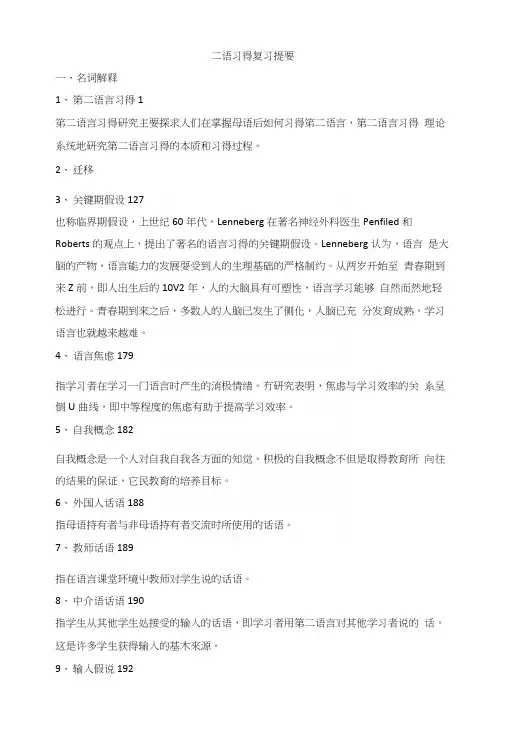
二语习得复习提要一、名词解释1、第二语言习得1笫二语言习得研究主要探求人们在掌握母语后如何习得笫二语言,第二语言习得理论系统地研究第二语言习得的本质和习得过程。
2、迁移3、关键期假设127也称临界期假设,上世纪60年代,Lenneberg在著名神经外科医生Penfiled和Roberts的观点上,提出了著名的语言习得的关键期假设。
Lenneberg认为,语言是大脑的产物,语言能力的发展耍受到人的生理基础的严格制约。
从两岁开始至青春期到来Z前,即人出生后的10V2年,人的大脑具有可塑性,语言学习能够自然而然地轻松进行。
青春期到來之后,多数人的人脑已发生了侧化,人脑已充分发育成熟,学习语言也就越来越难。
4、语言焦虑179指学习者在学习一门语言时产生的消极情绪。
冇研究表明,焦虑与学习效率的关系呈倒U曲线,即中等程度的焦虑有助于提高学习效率。
5、自我概念182自我概念是一个人对自我自我各方面的知觉。
积极的自我概念不但是取得教育所向往的结果的保证,它民教育的培养目标。
6、外国人话语188指母语持有者与非母语持有者交流时所使用的话语。
7、教师话语189指在语言课堂环境屮教师对学生说的话语。
8、中介语话语190指学生从其他学生处接受的输入的话语,即学习者用第二语言对其他学习者说的话,这是许多学生获得输入的基木來源。
9、输入假说192一些研究者把可理解输入看做是二语习得的一个主导因素,Krashen的输入假说是其中最有代表性的。
Krashen强调人类只通过理解信息或接受可理解输入习得语言。
他的输入假设的主要观点是:耍使语言习得得以发生,有必耍让学习者理解的输入语言包含稍高于其现冇水平的项目。
学习者利用情境提示理解这些语言,最后语言能力自然产生而无需传受。
他认为理想的输入应该有四个特征:可理解性,趣味及关联性,非语法程序安排,要有足够的输入量。
10、Swain的输出假设195该假设的思想概括起来,即通过产生出语言,口头的或者书面的,语言习得可以发生。
第二语言习得复习资料一、引言第二语言习得是一门研究人们如何学习和掌握除母语以外的语言的学科。
对于许多学习者来说,掌握一门第二语言不仅能够拓宽交流渠道,还能增加个人的文化视野和职业发展机会。
在这篇复习资料中,我们将系统地探讨第二语言习得的相关重要内容。
二、第二语言习得的理论基础(一)行为主义理论行为主义理论认为,语言学习是一种习惯的形成。
通过不断的刺激反应强化过程,学习者逐渐养成正确的语言使用习惯。
例如,反复练习某个语法结构或单词,在得到正确的反馈和强化后,就能熟练掌握。
(二)认知理论认知理论则强调学习者的内在认知过程。
认为学习者通过对语言规则的理解、归纳和推理来学习语言。
他们会主动构建语言知识体系,而不仅仅是被动地接受外界的刺激。
(三)社会文化理论社会文化理论关注语言学习所处的社会和文化环境。
认为语言学习是通过与他人的互动和参与社会文化活动实现的。
学习者在真实的交际情境中,借助他人的帮助和指导,逐渐发展语言能力。
三、第二语言习得的关键因素(一)语言输入丰富、准确、可理解的语言输入对于第二语言习得至关重要。
这包括听、读等多种形式的输入。
例如,听英语广播、阅读英语书籍等。
(二)语言输出学习者不仅要接受输入,还需要有机会进行语言输出,如说、写。
通过输出,学习者能够检验自己的语言知识,发现不足并加以改进。
(三)学习动机强烈的学习动机能够推动学习者积极投入学习。
动机可以是内在的,如对语言本身的兴趣;也可以是外在的,如为了通过考试或获得工作机会。
(四)学习策略有效的学习策略能够提高学习效率。
比如记忆策略、认知策略、元认知策略等。
学习者要学会根据自己的情况选择和运用合适的策略。
四、第二语言习得的阶段(一)初始阶段在这个阶段,学习者通常对第二语言的语音、词汇和基本语法有初步的了解和接触,但使用能力有限。
(二)中级阶段学习者能够进行简单的交流,掌握更多的语法和词汇,但在表达上可能还存在一些错误。
(三)高级阶段学习者能够较为流利和准确地运用第二语言进行交流,对语言的理解和运用达到较高水平。
第二语言习得复习题一、名词解释1.第二语言:指相对于第一语言来说,除儿童幼年最先接触和习得的语言,在此后习得的语言就是第二语言。
2. 第一语言:指儿童幼年最先接触和习得的语言。
3. 母语:指学习者所属种族、社团使用的语言,也称作“本族语”。
4,目的语:也叫目标语,一般指学习者正在学习的语言。
5,第二语言习得:简称SLA,是指人们在获得母语(第一语言)的基础上习得另一种或几种语言的过程。
也叫“二语习得”6,语言习得机制:乔姆斯基提出人脑中存在一个“语言习得机制”(LAD),它有以下一些特点:1.具有遗传性,为人类独有。
2.能使儿童加工语言材料,判断语言体系的发展,建立抽象规则。
3.可能已经具备一些普遍的语言特征,这些特征可以在所有人类语言中找到,因此,许多语法属性可能是先天存在于人类的大脑中,无需学习。
7,工具型动机:学习者对目的语群体没有兴趣,学习目的语只是为了掌握一个工具,用来提高自己的知识水平、改善社会地位。
8,习得与学习:克拉申认为“习得”通常指在自然状态下“下意识”的语言获得,而“学习”一般是指“有意识”的语言获得。
前者称为“内隐学习”,后者称为“外显学习”9,中介语:语言学习者在学习第二语言时所拥有的一种独立的语言系统,这种语言系统在结构上既不是学习者的母语也不是目的语,而是介于两者之间。
中介语系统在语音、词汇、语法、文化等方面都有表现。
但它又不是固定不变的,而是随着学习的发展,逐渐向目的语的正确形式靠拢。
10,普遍语法:乔姆斯基认为普遍语法是由一些原则条件和规则构成的系统,这些所有人类语言共有的因素是或特性是必然的而不是偶然的,原则系统和规则系统。
11,僵化:僵化(fossilization),也叫化石化或石化,是由Selinker于1972年在其中介语理论中提出的。
僵化是存在于“潜在的心理结构”中的一种机制,表现为某种母语背景的第二语言学习者会在目的语习得的某个阶段上停滞不前,无论学习者年龄大小,也无论其是否继续学习12,外国人话语:所谓“外国人话语”并不是指外国人的话语,而是指对外国人说的话语。
什么是二语习得理论第二语言习得理论侧重系统地研究第二语言习得的本质和习得的过程,即研究第二语言习得的心理过程、认知过程和语言过程,研究学习者在掌握了母语以后是如何学习另一套新的语言体系的,研究学习者学到了什么和没学到什么,研究为什么大部分学习者的第二语言无法达到母语的水平,研究母语对第二语言习得的影响,研究学习者运用第二语言的过程,研究语言教学对语言习得的影响,也研究第二语言学习者之间存在的巨大个体差异等等(蒋祖康,1999)。
Doughty和Ijn8(2003)指出,二语习得研究者认识到二语习得是在社会环境中发生的,并受到环境或大或小的影响。
然而,研究者同时也认识到语言学习和其他的学习一样,是不同的个体心灵内部的最大变化。
从这个意义上讲,二语习得研究已经逐步被认为是认知科学的一个分支。
总之,第二语言习得理论是心理学的一门分支学科,是对学习规律和学习条件的系统阐述,主要研究人类的行为特征和认知心理过程。
它既是一门应用性学科又是一种基础理论,因为学习理论注重把心理学的一般原理应用于学习领域,探讨行为是如何发生和变化的,并试图解释和预测行为的变化。
二语习得理论就是要为人们提供对二语习得的基本理解力,从而为形成人们的二语教育观奠定较为科学的基础。
第三节研究二语习得理论的意义和作用1.提供知识二语习得理论是人们对学习的问题进行科学研究和思维的指南和资源。
二语习得理论提供二语习得领域的知识,以及分析、探讨和从事学习研究的途径和方法,为外语教育工作者提供一个研究学习的框架,使他们把注意力集中在最值得研究的问题上。
2.知识的概括二语习得理论对有关二语习得法则的大量知识加以总结,使其系统化和条理化,以便于学习者掌握。
掌提了理论,就可以降低材料的复杂性,以便于对其进行分桥。
任何理论在抽象和筏括大旦具体知识的过程中,必然会失去一定的具体性和精确险,正因为这样。
理论才具有普遍的指导作用。
3.描述与解释(descrZbing and interP:etin8)二语习得理论是对人类从事的各种各样的::语教育实践的理性阐述。
第二语言习得研究考试资料试题知识点首先,为了更好地了解第二语言习得研究的相关知识点和考试内容,我们需要对这一领域进行深入研究。
本文将介绍第二语言习得研究的一些主要知识点,并提供一些考试资料试题,以帮助读者全面了解和掌握该领域的核心概念和重要内容。
第一部分:第二语言习得概述在本部分,我们将对第二语言习得的基本概念进行介绍,包括定义、研究方法和重要理论等。
第1知识点:第二语言习得的定义第二语言习得指的是个体在已经掌握第一语言的基础上,通过接触和学习第二语言来获得其语言能力的过程。
与第二语言学习不同,第二语言习得强调通过语言输入和交际环境的共同作用,自然地获得语言能力。
第2知识点:第二语言习得的研究方法第二语言习得的研究方法主要包括观察研究、实验研究和问卷调查等。
观察研究通过观察第二语言习得者的行为和语言产出,来了解其习得过程。
实验研究通过控制变量和实验条件,对第二语言习得进行实验性的研究。
问卷调查则通过调查问卷来收集第二语言习得者的相关数据。
第3知识点:第二语言习得的重要理论在第二语言习得研究中,有多个重要理论被提出和讨论,比如克里奥特斯理论、输入假设以及认知语言学等。
这些理论从不同角度解释了第二语言习得的过程和机制,为研究者提供了理论基础和研究框架。
第二部分:第二语言习得的影响因素在本部分,我们将介绍影响第二语言习得的一些主要因素,包括年龄因素、语言输入、认知因素等。
第4知识点:年龄因素对第二语言习得的影响年龄因素是影响第二语言习得的重要因素之一。
研究表明,儿童在早期习得第二语言时更容易实现母语水平的掌握,而成年人在第二语言习得上会遇到一些困难。
这主要与儿童期语言习得的生理机制和神经可塑性有关。
第5知识点:语言输入对第二语言习得的影响语言输入是指第二语言习得者在习得过程中接触到的语言材料。
研究发现,输入的丰富性和质量对于第二语言习得者的语言习得有着重要影响。
良好的语言输入能够提供更多的习得机会和语言模型,促进语言能力的发展。
⼆语习得复习资料⼆语习得复习资料第⼀章(填空+名词解释)第⼀节第⼆语⾔习得的基本概念母语:通常指的是学习者幼年习得的语⾔。
由于母语是家庭或者所属种族、社团使⽤的语⾔,因⽽也称作“本族语”。
⼀般说来,母语通常是⼉童出⽣以后最先接触、学会的语⾔。
因此,母语通常也被称作“第⼀语⾔”。
⽬的语:也称“⽬标语”,⼀般是指学习者正在学习的语⾔。
第⼀语⾔:指⼉童幼年最先接触和习得的语⾔。
第⼆语⾔强调的是语⾔习得的先后顺序,与语⾔习得环境⽆关。
“习得”是⼀种下意识、⾮正式的类似⼉童母语的获得过程。
学习者通常意识不到他们正在学习语⾔这⼀事实,但是能意识到他们正在⽤语⾔进⾏交际。
“学习”是指有意识地、正式的学习语⾔知识,能够明确地意识到所学的规则。
克拉申把这两个⽅式看作彼此独⽴的学习过程。
⽆接⼝观点、有接⼝的观点“第⼆语⾔习得”是指学习者在⽬的语国家学习⽬的语。
该⽬的语在⽬的语国家是公认的交际⼯具,当然也是学习者⽤来交际的⼯具。
“外语习得”是指学习者在本国学习⽬的语。
该⽬的语在本国不是作为整个社团的交际⼯具。
“⾃然的第⼆语⾔习得”是指以交际的⽅式获得第⼆语⾔,⽽且语⾔习得通常是在⾃然的社会环境下发⽣的。
“有指导的第⼆语⾔习得”是以教学指导的⽅式获得第⼆语⾔,语⾔习得通常是在课堂教学环境中发⽣的。
“语⾔能⼒”美国语⾔学家乔姆斯基⾸先提出了“语⾔能⼒”的概念。
其含义是,⼈类先天具有的、受遗传因素决定的掌握语⾔规则的能⼒。
这⾥所说的语⾔能⼒是指⼈们掌握语⾔知识的能⼒。
“语⾔表达”——在实际⽣活中运⽤语⾔进⾏社会交往的能⼒。
美国社会语⾔学家海姆斯第⼀次提出交际能⼒的概念,它包括四个⽅⾯的内容:语法性、可⾏性、得体性、现实性。
第三节第⼆语⾔习得发端发展简要回顾1.第⼆语⾔习得研究作为⼀门独⽴的学科是以1967年S.P.Corder(科德)发表的颇具影响的论⽂《学习者偏误的意义》以及1972年Selinker(塞林格)的《中介语》为标志。
第二语言习得复习整理一、名词解释1、母语:“母语”通常是指学习者家庭或者所属种族、社团使用的语言,因而也称作“本族语”。
一般情况下,母语通常是幼儿出生后最先接触、习得的语言。
也被称作“第一语言”。
2、目标语:“目标语”,也称“目的语”,指学习者正在学习的语言。
这种语言可能是他的第二语言、第三语言甚或第四语言。
它强调的是学习者正在学习的任何一种语言,与学习者的语言习得环境无关。
美国学生无论在美国学习汉语,还是在中国学习汉语,其目的语都是汉语。
如果他们同时在学习法语,那么法语也是他们的目的语。
对第二语言学习者而言,母语对其目的语的习得具有重要的影响。
3、第二语言:相对于第一语言而言,指在母语之后再学习另一种语言。
第二语言习得可能发生在自然环境,也可能在正规的课堂环境中。
在课堂环境下学习的第二语言被称为外语。
Ellis (1994)“第二语言”是相对于学习者习得的第一语言之外的任何一种其他语言而言的。
因此,“第二语言”自然包含第三、第四或更多的其他语言。
4、对比分析:对比分析是把两种语言进行对比,从而确定其中的相同点和不同点。
对比分析的最终目的是为了预测母语对第二语言学习可能会造成的影响,即第二语言学习者受母语干扰可能会出现的错误,从而确定教学的重点和难点,采取相应的预防性措施。
5、第二语言习得:人们在自然的语言环境中或者课堂环境中潜意识地或者有意识地获得母语之外的另一种语言。
6、中介语:“中介语”(interlanguage)这一概念是由语言学家塞林克(L.Selinker)于1969年提出来的。
中介语是指在第二语言习得过程中,学习者通过一定的学习策略,在目的语输入的基础上所形成的一种既不同于其第一语言也不同于目的语、随着学习的进展向目的语逐渐过渡的动态的语言系统。
7、偏误:偏误是对正确语言的偏离,也就是离开了轨道。
这种错误是系统的,有规律的,它反映说话者的语言能力。
8、偏误分析:系统分析学习者偏误,研究来源,揭示学习者中介语体系。
★1. SLA (Second language acquisition)is the process by which a language other than the mother tongue is learnt in a natural setting or in a classroom.★2. Acquisition vs. Learning (Krashen1982)Acquisition refers to the learning of a language unconsciously under natural settings where learners pay attention only to the meanings or contents rather than forms or grammars.Learning refers to the learning of a language consciously under educational settings where learners mainly pay attention to forms or grammars.3. Factors affecting SLASocial factors (external factors)Learner factors (internal factors)Social factors (external factors)Social contextLanguage policy and the attitude of the public sector;Social demandWith the trend of globalization of the world economy , it is widely accepted among educators and national leaders that proficiency in another language is an indispensable quality of educated peopleLearner factors (internal factors)Motivation ,Age ,Learning strategy4.Behaviorist learning theoryBehaviorist learning theory is a general theory of learning (i.e. it applies to all kinds of learning, not just language learning).It views learning as the formation of habits. The association of a particular response with a particular stimulus constituted a habit. It is formed when a particular stimulus became regularly linked with a particular response.When applied to SLA, the process of second language acquisition is regarded as a process of habit formation.5. The causes of errors according to behaviorismDifferences between the first and second language create learning difficulty which results in errors.Behaviorist learning theory predicts that transfer will take place from the first to the second language.Transfer will be negative when there is proactive inhibition. In this case errors will result.Errors, according to behaviorist theory, were the result of non-learning,rather than wrong learning.The means used to predict potential errors by behaviorists is Contrastive Analysis.6. StructuralismLanguage was viewed as a coded system consisting of structurally related elements (phonemes, morphemes, words, structures and sentence patterns)7. What is contrastive analysis (CA)?Contrastive analysis is an inductive investigative approach based on the distinctive elements in a language. It involves the comparison of two or more languages or subsystems of languages in order to determine both the differences and similarities between them. It could also be done within one language. Contrastive analysis can be both theoretical and applied according to varied purposes.8. Contrastive Analysis Hypothesis (CAH)Contrastive analysis is a way of comparing languages in order to determine potential errors for the ultimate purpose of isolating what needs to be learned and what does not need to be learned in an L2 situation.According to CAH, L2 errors are result of differences between the learner’s first language and the target language. The strong form of the hypothesis claims that these differences can be used to predict all errors that will occur. The weak form of the hypothesis claims that these differences can be used to identify some out of the total errors that actually arise.9.difference vs difficulty“Difference” is a linguistic concept, whereas “difficulty” is a psychological concept. Therefore, the level of learning difficulty cannot be inferred directly from the degree of difference between two language systems.10. Definition of Error analysis (EA)the study and analysis of the errors made by second and foreign language learners (Longman Dictionary of Applied Linguistics, p.96).It involves collecting samples of learner language, identifying the errors in these samples, describing these errors, classifying them according to their hypothesized causes, and evaluating theirs seriousness.11.Interlingual error: deviated forms resulting from the interference of one’s L1, or the negative transfer of one’s mother tongue.Intralingual error:①deviated forms in learner language that reflect learners’ transitional competence and which are the results of such learning process as overgeneralization.②confusion of L2 rules12. Factors causing errors1. Language transfer2. Overgeneralization3. Learner differences3. Strategies in L2 learning5. Strategies of L2 communicatione.g. The two students changed eyes and eyebrows in class.13. Types of learner strategyLearning strategy, Production strategy 表达策略Communication strategy:Communication strategies are employed when learners are faced with the task of communicating meanings for which they lack the requisite linguistic knowledge. Typical communication strategies are paraphrase and mime.14. Classifications of learning strategy(Cohen 2006)(2) By function: Metacognitive; Cognitive; Socio-affective(3) By skill: listening, speaking, reading, writing, vocabulary, or translation strategies.15. Meta-cognitive strategiesMeta-cognitive strategy is the planning for learning, thinking about the learning process, monitoring of one’s production or comprehension, and evaluating learning after an activity is completed.16. Cognitive strategiesCognitive strategies refer to the steps or operations used in learning or problem-solving that require direct analysis, transformation, or synthesis of learning material.Repetition, Resourcing, Directed physical response, Translation, Grouping, Note-taking , Deduction Recombination, Imagery, Auditory representation, Key word, Contextualization, Elaboration, Transfer, Inferencing17. Individual learner variablesPersonal factors:group dynamics; attitudes to the teacher and course materials; learning techniques General factors:age; aptitude; cognitive style; motivation; personality18. MotivationIntegrative motivation 融合型动机is present in learners who identify with the target culture, would like to resemble members of the target culture and who would like to participate in the target culture. It is assumed to be based in the personality of the learner.Instrumental orientation工具型动机refers to those cases where the learners are interested in learning the language for the possible benefits, that is, the learner’s goal is functional. Resultative motivation:因果性动机Learners’motivation is strongly affected by their achievement.Intrinsic motivation:内在兴趣动机Motivation as intrinsic interest.Motivation as a multi-componential construct:Motivation = effort + desire to achieve goal + attitudesTask motivation: the interest felt by the learner in performing different learning tasks.★19. Definition –interlanguageInterlanguage is the approximate language system that the learner constructs for use in communication through the target language. (Larry Selinker)It is independent of both the learner’s first language and the target language.It suggests that learners’ language is between L1 AND L2 and that it is a continuum along which all learners traverse.★20.Definition of fossilizationFossilization refers to the state in which the second language learners stop to learning when their internalized rule system contains rules different from the target language. That is to say, the interlanguage stops evolving towards the TL.21. Classification of fossilizationTemporary fossilization: the phenomenon is alterable under certain conditions.Permanent fossilizationThis means the learne r’s language stops evolving for ever. Because stable stage is not real fossilization, so there is no real permanent fossilization.22. Causes of fossilizationInternal: Motivation; Communicative needs; Acquisition deviceExternal: Communicative pressureLack of learning opportunitiesFeedback:positive cognitive feedbacks cause fossilization ;(e.g. “Oh,I see”)negative feedbacks help to prevent fossilization.(e.g. “I don’t understand you” )★23. Definition of UGCook(1985) summarizing the Chomskyan position, defines ‘universal grammar’ as ‘the pr operties inherent in the human mind’. Universal grammar consists of a set of general principles that apply to all language rather than a set of particular rules.24. MarkednessMarkedness refers to the idea that some linguistic structures are ‘special’ or ‘less natural’ or ‘less basic’ than others.Linguists working in the Chomskyan school suggest that linguistic rules can either be part of the core grammar (i.e. the universal rules) or be part of the periphery.Core rules are considered to be unmarked and therefore easily acquired.Periphery roles are considered to be and therefore different to learn.25.Krashen’s Monitor ModelKrashen’s monitor model mainly consists of the following five hypothses:(1) Acquisition-Learning Hypothesis:there are two kinds of ways of learning a second language ,i.e., acquisition and learning.(2) Natural Order Hypothesis:SLA follows a universal route that is not influenced by factors such as the learners’ first language, age, and the context (classroom or natural setting).Implications:Errors are developmental and are a natural byproduct of learning – tolerate them.Allow learners to make errors and do not correct them(3) The Input Hypothesis cIt laims a move along the developmental continuum by receiving comprehensible input.We acquire, only when we understand the structure that is “a little beyond” where we are now Comprehensible input is defined as L2 input just beyond the Learner’s current L2 competence, in terms of its syntactic complexity. If a learner’s current competence is i then comprehensible input is i+1. Input which is either too simple (i) or too complex (i+2/3/4…) will not be useful for acquisition.(4) The affective filter hypothesisSLA is affected by factors like Motivation, Self-confidence,Anxiety and so on.Learners who suffer from anxiety or lack of motivation or negative attitude somehow switch off their comprehension mechanisms and so even if they are provided comprehensible input, they will not be able to process the input. Therefore a low affective filter is important.(5) Monitor hypothesisBoth language learners and native speakers typically try to correct any errors in what they have just said. This is referred to as monitoring.Krashen uses the term Monitoring (with a big M) to refer to the way the learner used learnt knowledge to improve utterances produced by means of acquired knowledge.26. language transferLanguage transfer is the influence resulting from the similarities and differences between the target language and any other language that has been previously( and perhaps imperfectly ) acquired.★27. LAD (language acquisition device)The LAD is a system of principles that children are born with that helps them learn language, and accounts for the order in which children learn structures, and the mistakes they make as they learn.★28. critical age period hypothesisIt claims that there a period when language acquisition can take place naturally and effortlessly, but after a certain age the brain is no longer able to process language input in this. Researchers differ over when the critical period comes to an end.★29. field independent vs. field independentLearners are different in the ways of receiving, conceptualizing, organizing, and recalling information.Field dependents operate holistically (i.e. they see the field as a whole),Whereas field independents operate analytically (i.e. they see the field in terms of its component parts).★30. input vs. intakeInput refers to the language learners are exposed to.It serves as the data which learners must use to determine the rules of the target language.However, not all available input is processed by the learner, either because some of it is not understood or because some of it is not attended to.That part of input that is processed, assimilated and fed into the interlanguage system is referred to as intake.★31.attitudes vs. aptitude vs. intelligenceAttitudes refer to the learner’s beliefs about factors such as the target language culture, their own culture, their teacher and the learning tasks they are given.Aptitude refers to the specific ability a learner has for learning a second language.Intelligence refers to the general ability to master academic skills.32. competence vs. performanceWhen learners acquire a L2, they internalize rules which are then organized into a system. This constitutes their competence.The actual use of this system to comprehend and produce utterances is referred to as performance.33. OvergeneralizationIt refers to the extension of some general rule to items not covered by this rule in the target language.34. foreigner talk vs. teacher talkWhen native speakers address learners, they make adjustments in both language form and language function to facilitate understanding. These adjustments are referred to as foreigner talk.When teachers address learners, they make adjustments in both language form and language function to facilitate understanding. These adjustments are referred to as foreigner talk.35. formulaic speech vs. patternsFormulaic speech consists of expressions which are learned as unanalysable wholes and employed in particular occasions.Patterns are one type of formulaic speech. They are unanalysable units which have one or more open slots, e.g. ‘Can I have a —’。